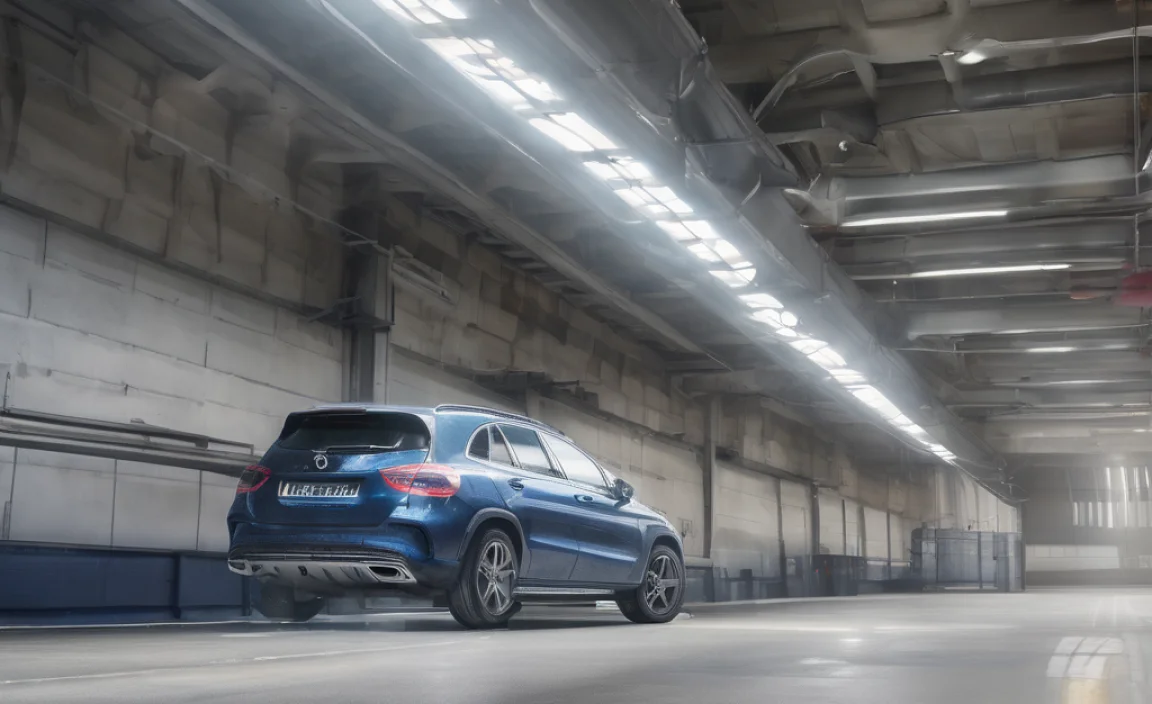GLA-Class Safety: Proven Essential Features
Your Mercedes-Benz GLA-Class is built with advanced safety in mind. This guide highlights key features like Active Brake Assist, Blind Spot Assist, and PRE-SAFE®, explaining how they work and what they mean for your peace of mind on the road.
Welcome, fellow Mercedes-Benz enthusiasts! When you think about your GLA-Class, you probably picture its stylish design and zippy performance. But under that sleek exterior lies a core commitment to your safety and the safety of those around you. Mercedes-Benz is renowned for its pioneering safety innovations, and the GLA-Class is no exception. Sometimes, all these advanced systems can feel a bit overwhelming. That’s where I come in! We’ll break down the essential safety features of your GLA-Class, making sure you understand how they enhance your driving experience and protect you. Let’s dive in and make sure you’re getting the most out of your vehicle’s protective capabilities!
Why GLA-Class Safety Features Matter

Your GLA-Class is more than just a compact SUV; it’s a sophisticated machine engineered with your well-being as a top priority. Mercedes-Benz invests heavily in research and development to create systems that can anticipate and help mitigate potential hazards. These aren’t just fancy add-ons; they are integral parts of the driving experience, working together to provide a comprehensive safety net. Understanding these features empowers you to drive with greater confidence and awareness.
The Evolution of Automotive Safety
Automakers like Mercedes-Benz have consistently pushed the boundaries of vehicle safety for decades. From the introduction of crumple zones and anti-lock brakes to today’s advanced driver-assistance systems (ADAS), the goal remains the same: to reduce accidents and protect occupants. The GLA-Class embodies this evolution, incorporating technologies that actively help prevent collisions and passively safeguard you if an impact occurs.
Essential GLA-Class Safety Features Explained

Let’s explore some of the most crucial safety systems you’ll find in your GLA-Class. We’ll keep it simple, focusing on what they do and why they’re important.
1. Active Brake Assist (ABA)
This is one of the most vital systems designed to help prevent or reduce the severity of frontal collisions.
How it Works: ABA uses radar sensors to monitor the distance to vehicles ahead. If it detects a significant risk of a collision, it will first issue a visual warning. If you don’t react, it will provide an audible warning. If you still don’t brake sufficiently, ABA will automatically apply partial or full braking to help you avoid or mitigate the impact.
Why it’s Essential: In bustling city traffic or on highways where distractions can happen, ABA acts as a vigilant co-pilot, ready to intervene when immediate action is needed. It’s particularly helpful for preventing rear-end collisions.
2. Blind Spot Assist
This system helps you avoid dangerous lane changes by alerting you to vehicles in your blind spots.
How it Works: Radar sensors integrated into the rear bumper scan the areas on either side of your vehicle that are not visible in the mirrors. If a vehicle is detected in your blind spot, a red warning triangle will illuminate in the corresponding exterior mirror. If you activate your turn signal while a vehicle is in the blind spot, the triangle will flash, and an audible warning will sound.
Why it’s Essential: Blind spots are a common cause of accidents, especially during lane changes. Blind Spot Assist provides an extra layer of awareness, helping you make safer maneuvers.
3. ATTENTION ASSIST®
Designed to detect signs of driver fatigue, this system can help prevent accidents caused by drowsiness.
How it Works: ATTENTION ASSIST® monitors your driving behavior over the first several minutes of a journey and then continuously analyzes various parameters. It uses your steering wheel movements to gauge your current alertness. If it detects patterns indicative of drowsiness, it will warn you with visual and audible alerts.
Why it’s Essential: Long drives or late-night commutes can lead to fatigue, impairing reaction times. ATTENTION ASSIST® serves as a much-needed reminder to take a break.
4. Active Lane Keeping Assist (ALKA)
This feature helps keep your vehicle centered within its lane, especially on highways.
How it Works: Using a camera, ALKA monitors lane markings on the road. If the system detects that your vehicle is unintentionally drifting out of its lane (without your turn signal activated), it will gently steer the car back into the lane. It can also provide a vibrating steering wheel as a warning.
Why it’s Essential: Accidental lane departures can be hazardous. ALKA acts proactively to correct your course, reducing the risk of sideswipes or running off the road.
5. SPEED LIMIT ASSIST
This system can help you stay aware of and adhere to posted speed limits.
How it Works: This feature uses the vehicle’s camera to recognize traffic signs, including speed limits. It can then display the detected speed limit on the instrument cluster and can also be configured to act as a speed limiter, preventing you from exceeding the recognized limit.
Why it’s Essential: It’s easy to inadvertently exceed the speed limit, especially on familiar roads or during overtaking. This system provides a helpful reminder and can even actively manage your speed.
6. PRE-SAFE® System
This is a groundbreaking system that actively prepares your vehicle and its occupants for a potential collision before it even happens.
How it Works: When PRE-SAFE® detects a likely accident scenario (e.g., through abrupt braking from a following car or signs of loss of control), it initiates protective measures. These can include automatically tensioning the seatbelts, adjusting the front seats to a more optimal position, and closing any open windows or the sunroof.
Why it’s Essential: By preparing the vehicle and occupants in advance, PRE-SAFE® maximizes the effectiveness of the passive safety systems (like airbags and seatbelt pre-tensioners) during an actual impact, potentially reducing injury severity. For more on passive safety, you can explore resources from the National Highway Traffic Safety Administration (NHTSA) regarding seat belt effectiveness.
7. Adaptive Cruise Control (Active Distance Assist DISTRONIC)
While often seen as a convenience feature, Adaptive Cruise Control significantly enhances safety, especially in traffic.
How it Works: DISTRONIC uses radar to maintain a set speed and a pre-selected distance from the vehicle in front. If the vehicle ahead slows down, DISTRONIC will automatically reduce your speed, even to a standstill. If the vehicle speeds up or changes lanes, DISTRONIC will accelerate back to your set speed.
Why it’s Essential: It reduces driver fatigue on long journeys and helps maintain a safe, consistent following distance, which is crucial for preventing rear-end collisions, especially in highway traffic.
8. Parking Assist Systems (PARKTRONIC & REAR VIEW CAMERA)
These systems make parking maneuvers safer and less stressful.
How it Works: PARKTRONIC uses ultrasonic sensors to detect obstacles around the vehicle and provides audible and visual warnings as you get closer. The standard rearview camera displays the area behind your vehicle on the infotainment screen, with dynamic guide lines to help you steer. Optional Active Parking Assist can even steer the vehicle into parking spaces.
Why it’s Essential: Low-speed impacts during parking are common. These systems provide enhanced visibility and warning, helping you avoid contact with other vehicles, pedestrians, or obstacles.
9. LED High Performance Headlights
Modern lighting technology plays a crucial role in nighttime safety.
How it Works: These headlights use Light Emitting Diodes (LEDs) for both low and high beams. They offer brighter, more natural light compared to traditional halogen bulbs, improving visibility significantly. Some advanced versions also feature Adaptive Highbeam Assist, which automatically adjusts the high beams to avoid dazzling oncoming drivers.
Why it’s Essential: Enhanced visibility at night allows you to see potential hazards sooner, react faster, and be more visible to other road users.
Understanding Mercedes-Benz Driver-Assistance Packages

Mercedes-Benz often groups many of these advanced safety features into optional packages, such as the Driving Assistance Package. While the exact features can vary by model year and specific trim, these packages are designed to offer a comprehensive suite of technologies.
Here’s a look at what you might find in a typical package:
| Feature Name | Primary Function | Benefit |
|---|---|---|
| Active Distance Assist DISTRONIC | Maintains set speed and distance to vehicle ahead. | Reduces driver fatigue, helps maintain safe following distance. |
| Active Steering Assist | Helps keep vehicle centered in its lane. | Enhances lane keeping, reduces driver strain on highways. |
| Active Brake Assist | Warns and brakes automatically to prevent/mitigate frontal collisions. | Crucial for avoiding rear-end accidents. |
| Active Blind Spot Assist | Warns of vehicles in blind spots and can intervene to prevent lane changes. | Increases safety during lane changes. |
| Active Lane Keeping Assist | Steers vehicle back into lane if it drifts unintentionally. | Prevents accidental lane departures. |
| Traffic Sign Assist | Recognizes and displays speed limits and other signs. | Helps driver adhere to road regulations. |
When purchasing or reviewing your GLA-Class, pay close attention to the specific packages and individual features included.
Passive Safety: The Foundation of Protection

While active safety systems aim to prevent accidents, passive safety systems are designed to protect you during an impact.
Advanced Airbag System: The GLA-Class is equipped with multiple airbags, including front, side, window, and knee airbags. These deploy strategically during a collision to cushion occupants.
High-Strength Body Structure: The vehicle’s chassis is engineered with high-strength steel and intelligent design to absorb and redirect impact forces away from the passenger cabin.
ISOFIX Child Seat Anchors: For younger passengers, standardized ISOFIX (or LATCH in North America) anchors make installing child safety seats secure and straightforward. You can find more information about child seat installation and safety standards on government safety websites.
Tire Pressure Monitoring System (TPMS): Although primarily for efficiency and performance, maintaining correct tire pressure also contributes to vehicle stability, especially during emergency maneuvers.
Tips for Maximizing Your GLA-Class’s Safety

Owning a vehicle with advanced safety features is fantastic, but they work best when you do!
Read Your Owner’s Manual: Seriously! It’s the best resource for understanding the specific functions, limitations, and operation of every system in your GLA-Class.
Keep Sensors Clean: Many safety systems rely on sensors (radar, cameras). Ensure these are free from dirt, mud, snow, or ice. Small dirt buildup can sometimes impair their function.
Understand System Limitations: While advanced, these systems are not foolproof. They have limitations and are designed to assist the driver, not replace them. Always maintain situational awareness and practice safe driving habits.
Regular Maintenance: Ensure your vehicle is serviced according to the manufacturer’s schedule. Proper maintenance keeps all systems, including safety components, functioning optimally.
Adjust Settings: Many systems, like ATTENTION ASSIST® or the speed limiter, have adjustable settings. Familiarize yourself with these to tailor the features to your preferences.
Frequently Asked Questions About GLA-Class Safety
Q1: What is the most important safety feature in my GLA-Class?
There isn’t one single “most important” feature, as they all work together. However, Active Brake Assist is critical for helping prevent or mitigate frontal collisions, which are very common. PRE-SAFE® is also vital as it prepares the car for a crash before it happens.
Q2: How do I know if my GLA-Class has advanced safety features like Active Brake Assist?
Check your vehicle’s original window sticker or owner’s manual. Features like these are often part of optional packages. You’ll also typically see indicators or buttons within the cabin related to these systems.
Q3: Can I turn off safety features like Active Lane Keeping Assist?
Yes, most driver-assistance systems can be deactivated by the driver. There’s usually a button on the steering wheel or dashboard that allows you to toggle these systems on or off. Your owner’s manual will detail how to do this for each specific feature.
Q4: How do I keep my GLA-Class’s safety sensors clean?
You can usually wipe down sensors (often located behind the grille or bumper, and on the windshield) with a soft cloth and mild cleaning solution, similar to how you’d clean your car’s exterior. Avoid abrasive cleaners or high-pressure washing directly on sensor areas.
Q5: Are these safety features effective in all weather conditions?
Most systems are designed to work in a wide range of conditions, but extreme weather (heavy snow, fog, or torrential rain) can sometimes affect sensor performance. Always exercise extra caution in poor weather and be aware of the limitations of the assistance systems.
Q6: What is the difference between Active Brake Assist and basic ABS (Anti-lock Braking System)?
ABS is a fundamental braking system that prevents wheels from locking up during hard braking, allowing you to steer. Active Brake Assist is a more advanced system that uses radar to detect potential collisions* and can automatically apply the brakes, even if you aren’t braking yourself.
Q7: How does PRE-SAFE® know when an accident is about to happen?
PRE-SAFE® uses a network of sensors, including radar and cameras, to monitor the surrounding traffic and your vehicle’s dynamics. It can detect situations like sudden decelerations of vehicles ahead, significant lateral acceleration indicating a loss of control, or imminent impacts.
Conclusion
Your Mercedes-Benz GLA-Class is equipped with a remarkable array of safety technologies, both active and passive, designed to protect you and your passengers on every journey. Features like Active Brake Assist, Blind Spot Assist, and the PRE-SAFE® system work tirelessly to anticipate hazards and prepare for the unexpected. By understanding how these systems function and by maintaining your vehicle properly, you can drive with greater confidence and peace of mind. Remember that these are advanced aids – always prioritize attentive, responsible driving. Enjoy the sophisticated safety that only a Mercedes-Benz can offer!